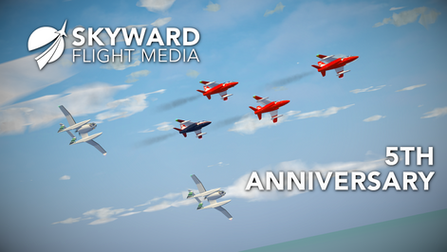Last weekend, we held the last round of matches for our dogfighting tournament in VRChat, in association with the VRC Black Aces. While everything went as intended, and most competitors had a fun time, it is clear that this tournament had a different feel than the ones that came before it. Let us discuss this a bit, to see the lessons that can be learned from it.

To start, I think it is necessary to give a bit of context as to how these tournaments are usually run. Before we announce the tournament, a voluntary member of the Black Aces staff will create a plane and a world. These are usually pretty straight forward, with little to no difference between creating a public world and a tournament world, which expedites development and reduces unnecessary factors.
Usually, there are no gimmicks or anything along those lines for tournaments; this means free skies for the competitors, who can now use their knowledge of air combat maneuvers (ACM) and basic fighter maneuvers (BFM) to dominate the competition. This usually, as it works in any other flight related game with an emphasis in pseudo-realism, will end up in the classic two circle or one circle fight flows.
While it is a crucial part of BFM theory, these fights can get extremely boring for an audience. You might as well be watching a NASCAR race at that point, if all you want to do is watch vehicles go around in circles. This is why we, as the members of staff, wanted to put a deterrent in place to avoid the amount of rate fights that could happen in the tournament.

After brainstorming with some friends, we came to the conclusion that we would make an encroaching barrier system similar to those in games like Fortnite or PUBG. VTail, one of the other members of staff and a close friend of Skyward, was the one to code the system for me to implement in the world. After plenty of testing, we found some values that could work in terms of damage over time, closure rates, etc.
The system ended up consisting of two phases: an initial closure phase (Phase 1) that closed in on the players from a radius of 8500 meters to a minimum of 2000 meters in the span of 80 seconds, after a 15-second delay from the start of the match had concluded. After that phase settled, a 45-second delay started ticking down for Phase 2, which had a minimum radius of 1500m, and closed in on the players in 30 seconds.
These values seemed fair at the time, and so we decided to lock them for the qualifier round of the tournament. To me, as the creator of the event world and the one that carried all the responsibility for the implementation of this new system, it proved to be quite the anxious night. I watched as, match after match, the barrier proved to be a bit of a hindrance for "traditional" dogfighting techniques that would deter the rate. No extensions were possible, no rolling scissors, nothing like that.

During the qualifiers, matches were determined mostly by who managed to set themselves up best during the initial merge. This is not typical of VRChat aviation tournaments, where classic BFM tends to be a bigger factor. This led me to have the realization that, in my naivety to try and attempt to mitigate the infamous rate fights, I had neutered most aspects of dogfighting that made it a bit more interesting.
The impact the barrier had is especially telling by looking at the statistics of the qualifier matches, assembled by Benjamin, one of the competitors and winner of this tournament. In this table, we can see that 30% of all qualifier matches ended when someone died to the encroaching barrier, nicknamed "The Storm" by the community. This was less than optimal.
The barrier values were, therefore, adjusted to try and give competitors more time in the initial closure phase to improve their experience and to lessen how much the barrier determined the results of the match.
During the finals, the results were much different, with a single match that ended when someone went outside the barrier and died from it. That meant that, aside from the higher skill level of the competitors during the finals, there was a significant decrease on the impact the barrier had on the matches. Most matches were, in actuality, determined by fuel starvation and even terrain collision due to said fuel starvation.

Matches were much more interesting at the beginning, but as we approached the final matches, it was clear that the barrier started acting more as a jail for the players. A jail that incentivized rate fights and nothing but rate fights. I realized that I had become the architect of my own hell, a rate fight purgatorium that lasted two whole hours.
The lesson I learned was as follows: If I will implement any systems like this in the future, I will need to stress test it for months in public worlds. This implementation only gave me pain, two hours of rate fights type-pain. I am not doing that again until I can make sure none of this happens, ever again. Period. All the screenshots in the article are courtesy of VTail, thanks a lot!
About the writer:
Santiago "Cubeboy" Cuberos

Longtime aviation fanatic with particular preference towards military aviation and its history. Said interests date back to the early 2000s, leading into his livelong dive into civil and combat flight simulators. He has been involved in a few communities, but only started being active around the mid 2010s. Joined as a Spanish to English translator in 2017, he has been active as the co-founder and writer ever since. Twitter | Discord: Cubeboy


















.png)